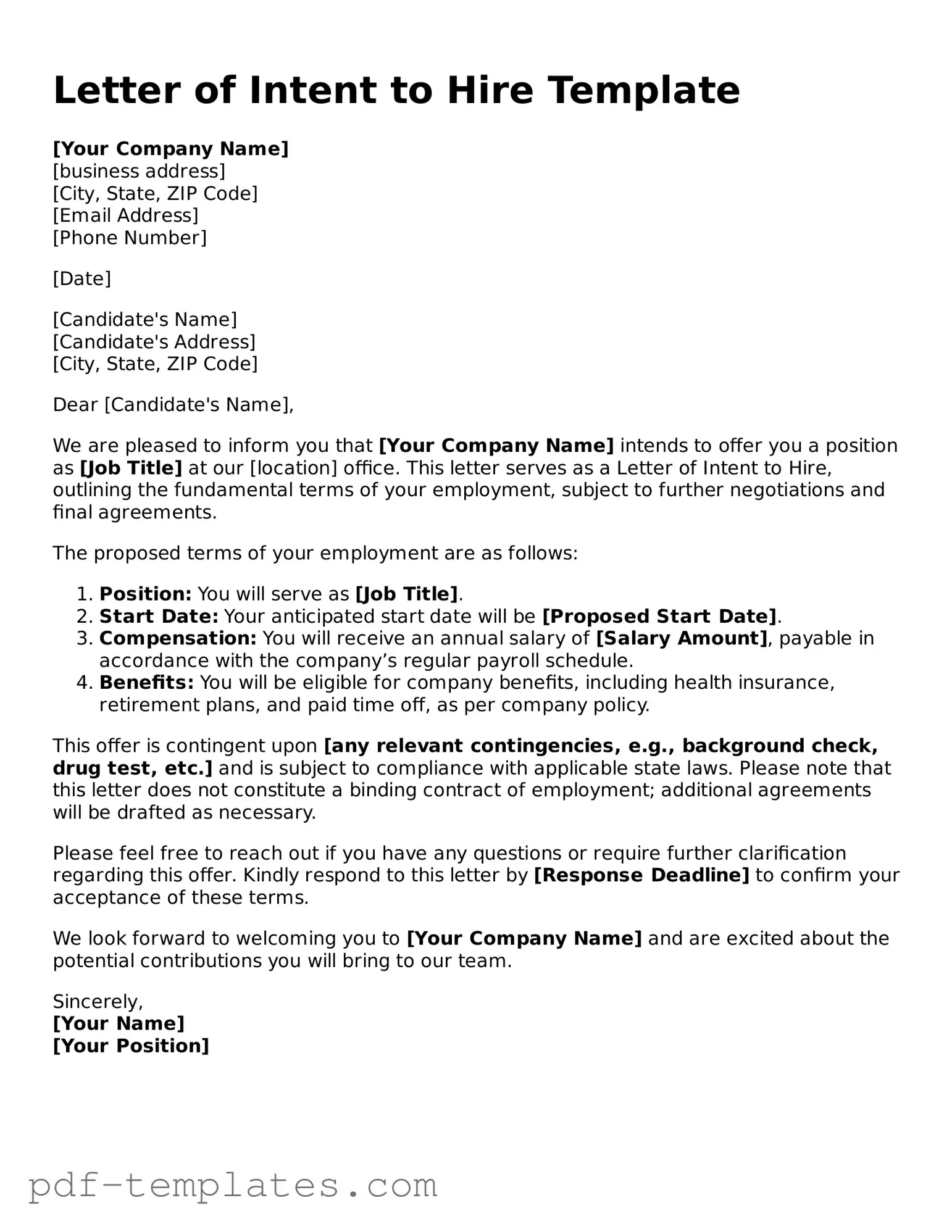The Letter of Intent (LOI) is often compared to a Memorandum of Understanding (MOU). Both documents serve as preliminary agreements that outline the intentions of the parties involved. While an LOI may focus specifically on the hiring of an individual, an MOU can cover a broader range of topics. Both documents indicate a commitment to negotiate in good faith, but an MOU typically has a more formal tone and may include specific terms that the parties agree to consider during future negotiations.
A Job Offer Letter is another document similar to the Letter of Intent to Hire. A job offer letter is a formal proposal from an employer to a candidate, detailing the terms of employment, such as salary, benefits, and job responsibilities. Unlike the LOI, which expresses intent to hire, the job offer letter is more definitive and typically requires the candidate’s acceptance to finalize the hiring process. Both documents convey the employer’s interest in the candidate but differ in their level of commitment.
The Non-Disclosure Agreement (NDA) is also comparable to the Letter of Intent to Hire. An NDA protects sensitive information shared between parties during negotiations. When a company expresses intent to hire, it may also wish to protect its proprietary information. Both documents signify a level of trust and commitment to confidentiality, although the NDA focuses specifically on safeguarding information rather than employment terms.
In addition to these employment-related documents, understanding the educational landscape is equally important for families considering alternative schooling options. For instance, the Alaska Homeschool Letter of Intent form is a vital document that parents must submit to notify the state of their intent to homeschool their children. This form not only facilitates compliance with educational regulations but also ensures that families embark on their homeschooling journey with clarity. For more information, you can visit hsintentletter.com/alaska-homeschool-letter-of-intent-form/.
A Confidentiality Agreement is similar to an NDA but may be broader in scope. This document ensures that both parties agree to keep certain information private. In the context of a Letter of Intent to Hire, a Confidentiality Agreement may be necessary to protect trade secrets or company strategies discussed during the hiring process. Both agreements aim to foster a secure environment for discussions, but they may differ in the specifics of what information is protected.
The Offer of Employment is another document that resembles the Letter of Intent to Hire. This document formally communicates the employer’s decision to hire a candidate, outlining the position, salary, and other relevant details. While the LOI expresses a desire to hire, the Offer of Employment is a more formalized step in the hiring process. Both documents reflect the employer's interest but differ in their legal implications and specificity.
The Candidate Acceptance Form is closely related to the Letter of Intent to Hire. This form is used by candidates to formally accept a job offer. While the LOI indicates the employer's intent to hire, the Candidate Acceptance Form confirms the candidate's agreement to the terms presented. Both documents are essential steps in the hiring process, transitioning from intent to commitment.
The Recruitment Agreement is another document that shares similarities with the Letter of Intent to Hire. This agreement outlines the terms between a company and a recruitment agency regarding the hiring process. It sets expectations for both parties and may include fees and responsibilities. While the LOI focuses on an individual candidate, the Recruitment Agreement addresses the broader relationship between the employer and the recruitment agency, yet both emphasize the goal of hiring.
Lastly, the Candidate Profile Document is akin to the Letter of Intent to Hire. This document summarizes the qualifications and experiences of a candidate, serving as a reference during the hiring process. While the LOI expresses the employer's intent to bring a candidate on board, the Candidate Profile Document provides the necessary context to support that decision. Both documents play crucial roles in the decision-making process, highlighting the candidate's fit for the position.
